List of Contents
What is the Multi-cloud Management Market Size?
The global multi-cloud management market size accounted for USD 16.02 billion in 2025 and is predicted to increase from USD 20.49 billion in 2026 to approximately USD 147.12 billion by 2034, expanding at a CAGR of 27.94% from 2025 to 2034. The growth of the market is driven by increasing need for flexibility, cost optimization, and risk mitigation through the use of multiple cloud service providers.
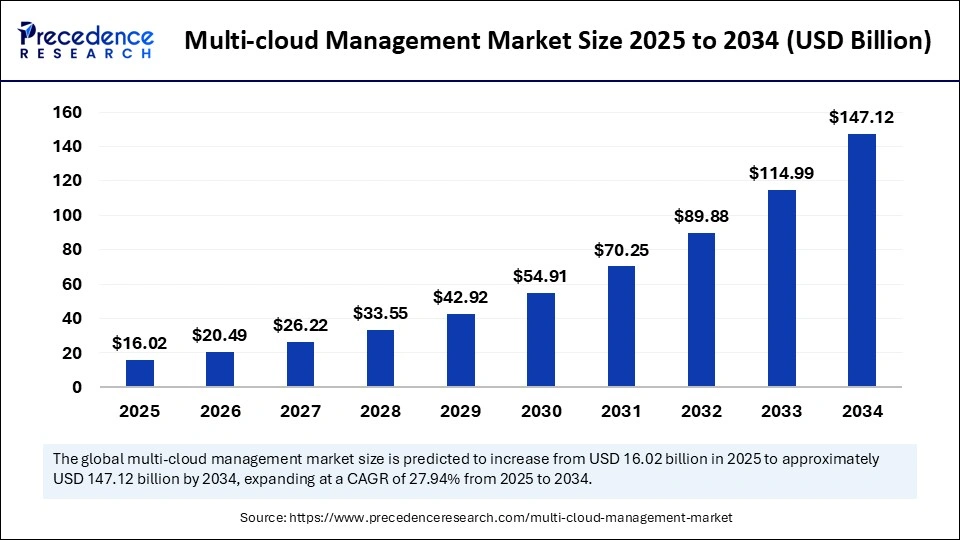
Multi-cloud Management Market Key Takeaways
- In terms of revenue, the multi-cloud management market is valued at $16.02 billion in 2025.
- It is projected to reach $147.12 billion by 2034.
- The market is expected to grow at a CAGR of 27.94% from 2025 to 2034.
- North America dominated the multi-cloud management market with the largest revenue share of 36% in 2024.
- Asia Pacific is projected to grow at the fastest CAGR in the coming years 2025 to 2034.
- By solution, the cloud automation segment held the highest revenue share of 27% in 2024.
- By solution, the security & risk management segment is expected to witness significant growth during the predicted timeframe from 2025 to 2034.
- By enterprise size, the large enterprises segment contributed the biggest revenue share of 59% in 2024.
- By enterprise size, the small & medium enterprises (SEM) segment is expected to grow at the fastest rate during the forecast period from 2025 to 2034.
- By end-user, the BFSI segment accounted for the biggest revenue share of 26% in 2024.
- By end-user, the IT & telecom segment is expected to grow at the fastest rate in the coming years from 2025 to 2034.
Artificial Intelligence: The Next Growth Catalyst in Multi-cloud Management
Artificial Intelligence AI is revolutionizing multi-cloud management by improving security through real-time threat detection and automated resource allocation. It offers centralized dashboards that make monitoring easier and provide useful information for a variety of cloud environments. It also facilitates simpler workload migration and prevents vendor lock-in by enabling predictive maintenance to minimize downtime. Additionally, AI automates routine tasks such as resource provisioning and security management, reducing manual efforts and improving operational efficiency.
Strategic Overview of the Global Multi-cloud Management Industry
The multi-cloud management market is expanding rapidly as more businesses are using multiple cloud platforms to mitigate vendor lock-in, improve operational efficiency, and customize services to meet particular business requirements. The increasing complexity of IT environments and the requirement for unified management tools that provide security automation and visibility across various cloud infrastructures are boosting the demand for multi-cloud management solutions. Managing several cloud environments becomes crucial as businesses grow to facilitate digital transformation, hybrid work, and application modernization. Industry adoption of multi-cloud management platforms is being further fueled by features like cost-tracking policy enforcement and advanced analytics.
What's driving the shift to multi-cloud strategies?
Multi-cloud strategies are being adopted by businesses to increase resilience, scalability, and control. By using this strategy, businesses can take advantage of the distinct advantages offered by various cloud providers while maintaining consistency and compliance across workloads and apps. To isolate crucial operations and reduce risk, the use of multiple cloud environments is also encouraged by growing cybersecurity concerns and regulatory requirements. Furthermore, even mid-sized businesses can now more easily implement multi-cloud deployments, thanks to the increasing availability of AI-powered management solutions that streamline orchestration.
Market Outlook
- Market Growth Overview: The Multi-cloud Management market is expected to grow significantly between 2025 and 2034, driven by widespread adoption, integration of AI and machine learning, and preference for hybrid cloud architecture, which combines public and private clouds, is a growing trend.
- Sustainability Trends: Sustainability trends involve a focus on e-waste reduction and hardware lifecycle management, leveraging provider initiatives, and integrating ESG principles directly into multi-cloud strategies, which is becoming a core business objective, moving beyond compliance.
- Major Investors: Major investors in the market include Large Technology Corporations, Amazon Web Services, Venture Capital Firms, Google Cloud, and Insight Partners.
- Startup Economy: The startup economy is focused on security and compliance solutions, application portability and containerization, and e-commerce and D2C platforms.
Multi-cloud Management MarketGrowth Factors
- Digital Transformation Initiatives: Organizations are rapidly adopting cloud-based solutions to modernize operations and improve agility, fueling the need for multi-cloud management tools.
- Avoidance of Vendor Lock-in: Enterprise prefers to use multiple cloud providers to reduce dependency on a single vendor and increase flexibility.
- Complex IT Environments: Managing various applications, platforms, and data across different cloud infrastructures creates a demand for centralized multi-cloud management platforms.
- Security and Compliance Needs: Regulatory requirements and cybersecurity concerns drive businesses to distribute workloads across clouds for better risk mitigation.
- Hybrid and Edge Computing Growth: The expansion of hybrid cloud and edge computing solutions requires integrated management capabilities across diverse environments.
- DevOps and Containerization Adoption: The rise of DevOps practices and containerized applications supports the need for consistent deployment and management across clouds.
Market Scope
| Report Coverage | Details |
| Market Size by 2034 | USD 147.12 Billion |
| Market Size in 2025 | USD 16.02 Billion |
| Market Size in 2026 | USD 20.49 Billion |
| Market Growth Rate from 2025 to 2034 | CAGR of 27.94% |
| Dominating Region | North America |
| Fastest Growing Region | Asia Pacific |
| Base Year | 2024 |
| Forecast Period | 2025 to 2034 |
| Segments Covered | Solution, Enterprise Size, End-user, and Region |
| Regions Covered | North America, Europe, Asia-Pacific, Latin America, and Middle East & Africa |
Market Dynamics
Drivers
Need for High-Level Data Security and Risk Management
The rising need for high-level data security and risk management is a key factor driving the growth of the multi-cloud management market. Businesses are placing a higher priority on thorough security frameworks due to the proliferation of sensitive data stored across multiple cloud environments. To manage encryption policies, ensure compliance, and keep an eye on threats, multi-cloud management platforms provide centralized visibility and control. To protect company assets, they also support advanced identity and access management (IAM) solutions. Strong risk management is becoming a must as regulatory scrutiny increases.
- In March 2025, Google signed a definitive agreement to acquire cloud security platform Wiz for USD 32 billion. This aims to enhance Google Cloud's security capabilities, providing customers with comprehensive protection across multi-cloud environments. The integration will bolster data protection and risk management in complex cloud infrastructures.
https://cloud.google.com/blog/products/identity-security/google-announces-agreement-acquire-wiz
Rising Adoption of Cloud Services Across Industries
Businesses in a variety of industries, including manufacturing, retail, healthcare, and BFSI, are using cloud infrastructure more and more to help with digital transformation projects. The need for smooth integration and management across public, private, and hybrid cloud configurations is increasing due to this broad adoption. Businesses can improve collaboration, streamline workloads, and speed up deployment times with the aid of multi-cloud management tools. Effective orchestration becomes increasingly important as cloud-native applications expand.
Restraints
Rising Security and Compliance Challenges
Rising security concerns are expected to restrain the growth of the multi-cloud management market. Inconsistent enforcement of policies and vulnerabilities may result from managing security across various cloud platforms. It can be challenging for multi-cloud setups to maintain consistent adherence to laws like the CCPA, GDPR, and HIPPA. Businesses find it difficult to manage multiple cloud environments. This further complicates compliance in international operations and leads to data breaches. To identify threats on all platforms instantly, businesses must put strict monitoring into place.
- In June 2025, Microsoft's report highlights the need for Zero Trust and risk-based cloud security to meet growing compliance demands. It found that many organizations lack unified visibility across cloud environments, increasing risks of non-compliance. The report recommends adopting cloud-native security solutions to proactively manage evolving threats. (Source: https://www.axios.com)
High Cost of Implementation and Maintenance
Although multi-cloud management can reduce expenses in the long run, it requires a hefty upfront cost for infrastructure, tools, and training. IT budgets can be strained by licensing fees, integration services, and support expenses, particularly for SMs. Total cost of ownership (TCO) is also influenced by continuing upkeep and upgrades. Furthermore, organizations might have to pay for unanticipated expenses like cross-platform compatibility fixes and data agreement fees. Companies are frequently forced to sacrifice features or performance due to financial constraints. Moreover, integrating different cloud services and platforms can be difficult, creating challenges in the market.
Opportunities
Increasing Cloud Adoption Among SMEs
Cloud technology adoption is accelerating among small and medium-sized businesses to improve competitiveness and agility. Managing several cloud services becomes crucial for cost reduction and operational effectiveness as they grow. Furthermore, there is a sizable unexplored market for multi-cloud solutions that are simplified and reasonably priced for SMEs. Vendors in this market can draw in a sizable clientele by providing low-maintenance, easily deployable solutions.
- In April 2025, Oracle launched Cloud Customer solutions specifically tailored for SMEs to deploy cloud services on-premises or in hybrid setups. This offering enables smaller enterprises to gain the benefits of cloud scalability and multi-cloud flexibility while maintaining control over sensitive data. Oracle also provides simplified management tools designed for limited IT resources. Source: https://www.oracle.com)
Expansion of Edge Computing and IoT
The proliferation of edge computing and IoT devices is producing enormous volumes of decentralized data that require management and processing in real time. This increasing demand can be met by multi-cloud platforms that facilitate edge and communication with central cloud systems, presenting additional opportunities. This trend is especially pertinent to industrial IoT driverless cars and smart cities.
By Solution Analysis
Why Did Cloud Automation Dominate the Multi-Cloud Management Market in 2024?
The cloud automation segment dominated the multi-cloud management market with the largest revenue share of 27% in 2024 due to its enhanced scalability. Clod automation solutions decrease manual intervention and streamline operations. With more businesses embracing hybrid cloud and DevOps approaches, the need for automation tools is increasing. These tools aid in the effective management of intricate infrastructures. Automation's pivotal role in guaranteeing consistency and speed across cloud environments has been further fueled by the emergence of container orchestration platforms like Kubernetes and the integration of AI-driven operations.
The security & risk management segment is expected to witness significant growth during the predicted timeframe. This is mainly due to the increasing concerns among businesses about data breaches and legal compliance. Organizations are prioritizing zero-trust security frameworks and AI-powered threat detection as they handle more sensitive data in dispersed environments. To protect assets and satisfy changing compliance requirements, businesses are being compelled to embrace unified security models due to the increasing complexity of multi-cloud configurations.
By Enterprise Size Analysis
Why Did Large Enterprises Dominate the Multi-Cloud Management Market in 2024?
The large enterprises segment held the biggest market share of 59% in 2024. Large enterprises often use multiple cloud environments due to their vast operations, sophisticated IT infrastructures, and significant financial resources. These enterprises use multi-cloud strategies to prevent vendor lock-in, improve scalability, and guarantee business continuity. To address the complex needs of large enterprises, IBM, for example, is acquiring Hashi Corp to strengthen its cloud management offerings. Additionally, these enterprises heavily invest in multi-cloud solutions to meet strict regulatory requirements.
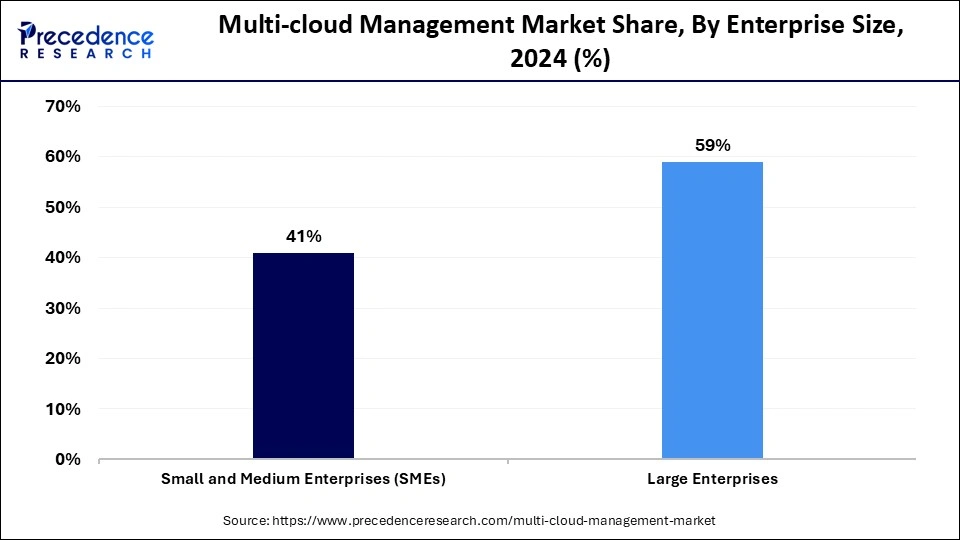
The small & medium enterprises (SEM) segment is expected to grow at the fastest rate during the forecast period, driven by the need for operational agility and the growing availability of cloud technologies. With cloud-managed services, SMEs can use enterprise-grade technologies at a lower cost and without having to make large upfront investments. The growth of pay-as-you-go and subscription-based business models makes this adoption even easier. As SMEs continue to embrace digital transformation, there is a high need for flexible and scalable multi-cloud management solutions.
By End-User Analysis
Why Did the BFSI Sector Lead the Multi-Cloud Management Market in 2024?
The BFSI segment dominated the multi-cloud management market with the major revenue share of 26% in 2024, owing to its urgent requirement for strict regulatory compliance, strong disaster recovery, and high availability. To guarantee data redundancy, reduce downtime, and improve customer experiences, financial institutions mainly rely on multi-cloud strategies. Multi-cloud infrastructure is essential to these organizations' digital transformation journeys because they require scalable and secure environments to manage massive volumes of sensitive data.
The IT & telecom segment is expected to grow at the fastest rate in the coming years. This is mainly due to the rising dependency of It and telecom businesses on quick innovation cycles and flexible, scalable infrastructure. Cloud environments that are distributed and flexible are becoming increasingly important as service providers implement 5G, IoT, and cloud-native platforms. The adoption of multi-cloud environments is rising in this industry to effectively manage workloads and enhance service delivery.
U.S. Multi-cloud Management Market Trends
The U.S. multi-cloud management market size was exhibited at USD 5.53 billion in 2025 and is projected to be worth around USD 40.54 billion by 2034, growing at a CAGR of 28.20% from 2025 to 2034.
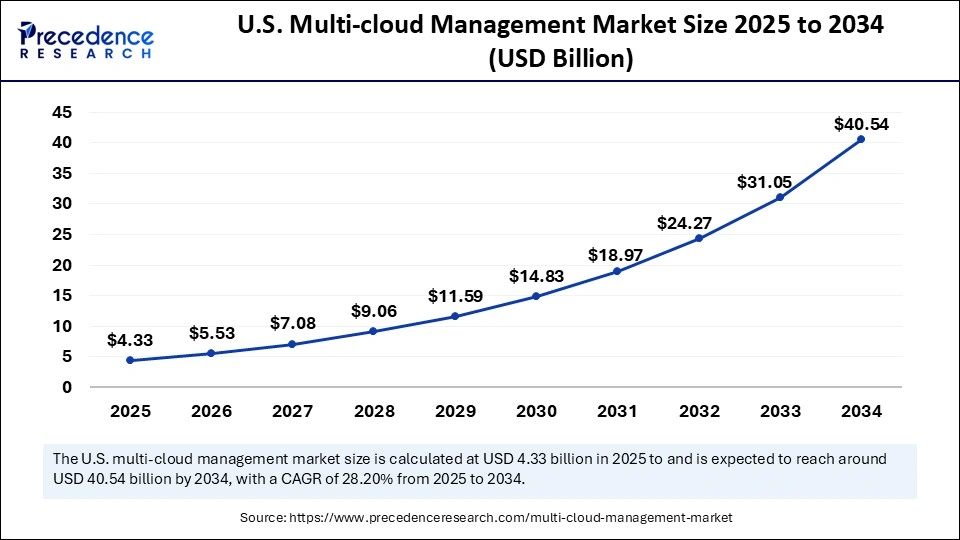
The U.S. need robust security, effective cost optimization, and leveraging AI and automation for efficient operations. High multi-cloud adoption rates among enterprises are fueling the demand for solutions that provide unified management, reduce vendor lock-in, and ensure regulatory compliance. The expansion of use of hybrid cloud models, the strategic integration of containerization with Kubernetes, and addressing industry-specific needs.
North America accounted for the biggest revenue share of 36% in 2024
This is mainly due to its developed cloud infrastructure. There is a strong concentration of top tech firms on enhancing service delivery, boosting the demand for cloud environments. The region is an early adopter of cloud computing. To promote innovation and boost operational efficiency, businesses in this region have made significant investments in hybrid and multi-cloud environments. The growing concerns about data security and the increasing reliance on multi-cloud management solutions are sustaining the region's long-term growth in the market.
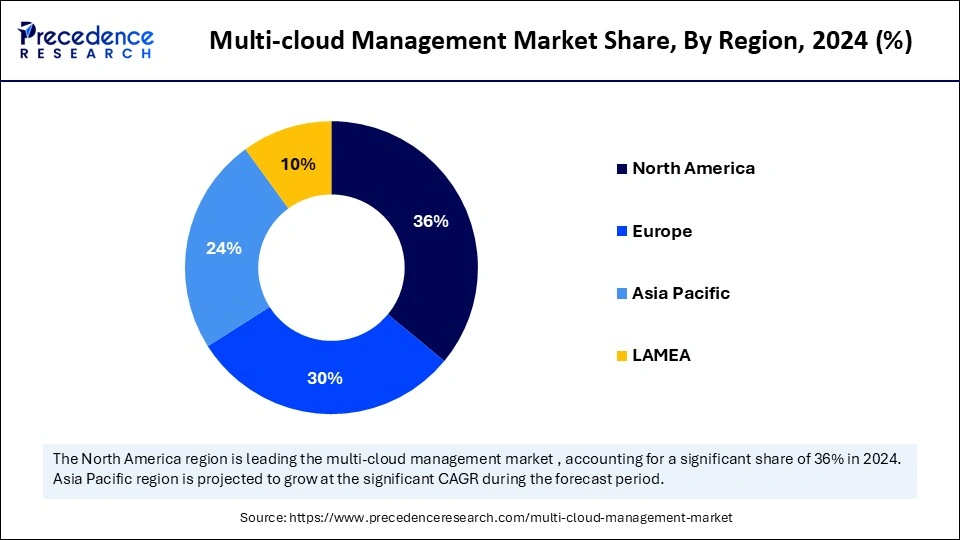
Why Is Asia Pacific the Fastest-Growing Region in the Cloud Computing Market?
Asia Pacific is expected to witness the fastest growth in the upcoming years, driven by growing IT infrastructure, quickening digital transformation, and rising cloud adoption among startups and enterprises. There is an increasing need for scalable cloud solutions among businesses. The rising number of SMEs in the region are looking to expand their operations worldwide, creating the need for multi-cloud environments. The rising government programs that support cloud computing and advanced technologies further support regional market growth.
China Multi-cloud Management Market Trends
China's accelerated adoption of enterprise digital transformation and unique regulatory requirements, expansion of edge computing and containerization technologies, and need for low-latency data processing for IoT applications are driving the expansion of distributed cloud and edge computing models, which multi-cloud platforms help manage and integrate.
Europe is considered to be a significantly growing area.
The growth of the multi-cloud management market in the region is attributed to strict laws governing data protection and a growing focus on digital sovereignty. Multi-cloud models are being adopted by organizations throughout the region to improve compliance and lessen dependency on a single provider. The rapid expansion of the IT and telecom businesses further contributes to the growth of the market in the region.
Germany Multi-cloud Management Market Trends
Germany's multi-cloud management market is driven by strict data sovereignty and GDPR compliance needs, favoring robust security and hybrid cloud strategies. Enterprises are increasingly integrating AI and automation for efficient operations and cost management across complex environments. The market seeks to avoid vendor lock-in and address the talent shortage through vendor-neutral platforms and managed services.
Value Chain Analysis of the Multi-cloud Management Market
- Cloud Infrastructure & Platform Provision
This stage involves the foundational provision of public and private cloud services, including computing, storage, networking, and core development tools.
Key Players: Amazon Web Services (AWS), Google Cloud, and Microsoft (Azure) - Multi-Cloud Management Technology & Software Development
This stage is centered on developing the specialized software, tools, and platforms that enable unified visibility, control, and automation across diverse cloud environments.
Key Players: VMware, Cisco Systems, Inc., IBM, and Flexera. - System Integration & Managed Services
This stage involves integrating the various management technologies and platforms into a seamless, operational solution for the end-user, often followed by ongoing support and managed services.
Key Players: Wipro, HCL Technologies, and Accenture. - End-Use & Application
The final stage involves the application of multi-cloud management solutions by diverse end-users across various sectors, including BFSI, healthcare, manufacturing, and IT/Telecom.
Key Players: Walmart
Top Companies in the Multi-cloud Management Market & Their Offerings
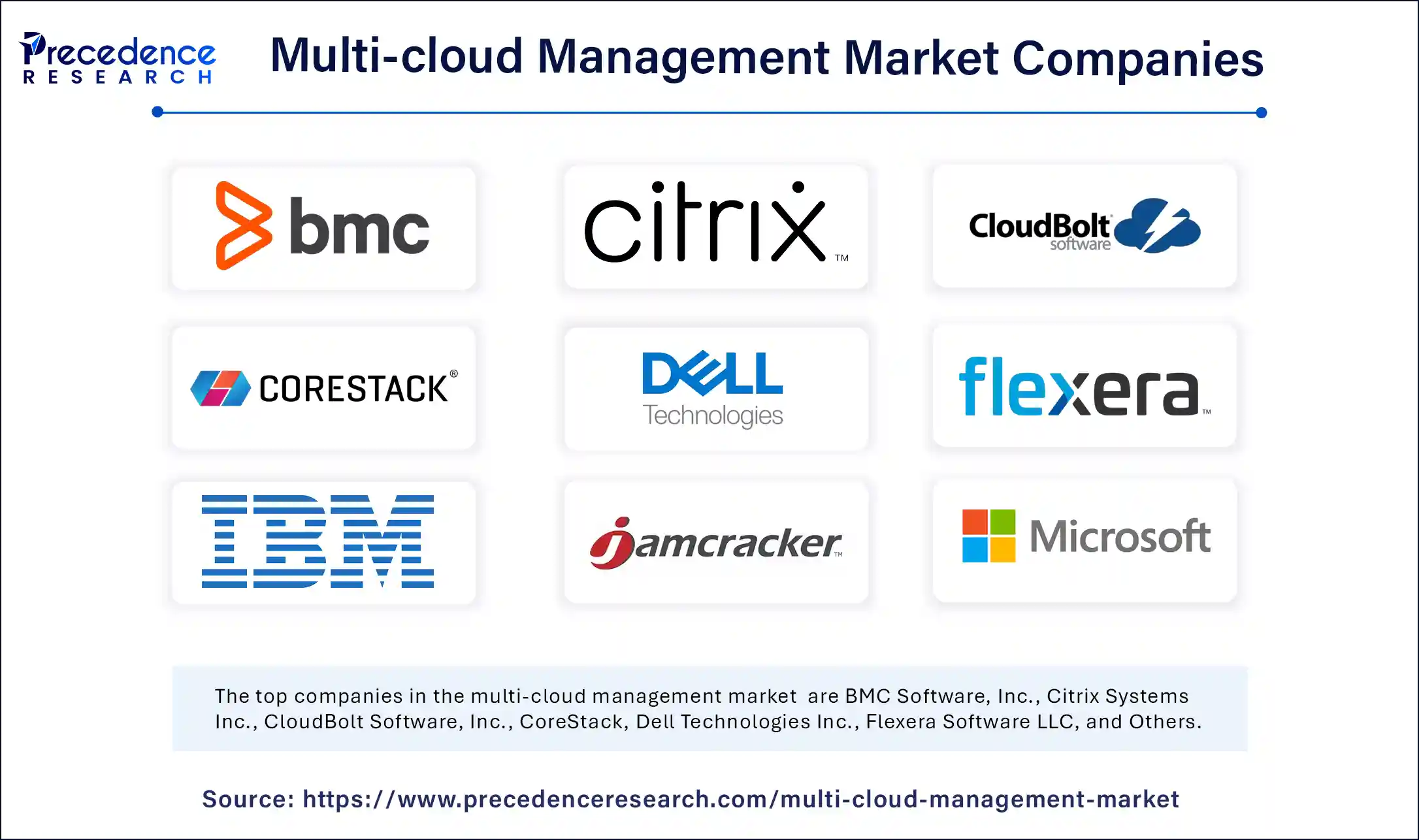
- BMC Software, Inc. contributes to the multi-cloud management market by offering a comprehensive suite of IT operations and service management solutions that provide a unified view across complex, multi-cloud environments.
- Citrix Systems Inc. contributes by providing a multi-cloud workspace solution that enables secure delivery of apps and data across any cloud, hybrid, or multi-cloud environment. Their offerings focus on providing a seamless and secure digital workspace experience, abstracting the underlying cloud complexity for the end-user.
- CloudBolt Software, Inc. contributes by providing a multi-cloud management platform that unifies cloud governance, cost management, and automation across diverse cloud providers. Their platform helps enterprises achieve self-service IT while maintaining control and optimizing spending across their hybrid and multi-cloud infrastructure.
- CoreStack contributes to the market with its AI-powered multi-cloud governance and FinOps platform designed to help enterprises manage compliance, security, operations, and costs across multiple cloud providers. Their solution provides a unified control plane that enables automated governance and optimization in complex cloud landscapes.
- Dell Technologies Inc. contributes through its extensive portfolio of IT infrastructure solutions that enable the creation of hybrid and multi-cloud environments, including integrated hardware and software for private clouds that can be managed in a multi-cloud strategy. Their offerings facilitate consistent infrastructure and operations across private and public clouds.
- Flexera Software LLC contributes to the multi-cloud management market with its cloud cost optimization and management platform that helps businesses understand and manage spending across various cloud providers. Their solutions provide detailed analytics and automation to maximize cost efficiency and ensure compliance in a multi-cloud environment.
- International Business Machines Corp. (IBM) contributes by offering a broad range of multi-cloud management solutions and services, including its Red Hat OpenShift platform, which facilitates application portability and consistent operations across different clouds. IBM's focus is on helping enterprises modernize applications and manage complex hybrid and multi-cloud architectures.
- Jamcracker Inc. contributes to the market by providing a multi-cloud management platform (CMP) that offers a single pane of glass for managing services, security, compliance, and costs across multiple cloud providers. Their platform is designed to streamline cloud service delivery and management for service providers and enterprises.
- Microsoft Corp. contributes significantly through its Azure cloud platform and related management tools like Azure Arc, which provides a single management console for hybrid and multi-cloud resources. Their focus is on extending
- Azure services and management capabilities to any infrastructure, whether on-premises, multi-cloud, or edge.
- Trianz contributes to the market as a global management and technology consulting firm that helps businesses design, implement, and manage their multi-cloud strategies and operations.
- VMware Inc. contributes with its multi-cloud management solutions, which offer a consistent operating model and infrastructure across a diverse range of cloud environments, making it easier for enterprises to move applications and data.
Latest Announcement by Industry Leader
- On 13 September 2024, Oracle announced its strategy to enhance security and efficiency through AI-powered autonomous databases and multi-cloud integration. Larry Ellison, CTO and Executive Chairman of Oracle, emphasized, "Autonomous systems are the future, offering unparalleled security and operational efficiency in multi-cloud environments." (Source: https://cio.economictimes.indiatimes.com)
Recent Developments
- On 5 May 2025, At the IMB Think 2025 conference, IBM emphasized themes like AI productivity and scalable AI architecture. The event highlighted IBMs commitment to enhancing AI capabilities across hybrid and multi-cloud environments, focusing on cost optimization and trusted data management.
(Source: https://en.wikipedia.org) - On 19 May 2025, Nvidia announced the launch of Lepton, a software platform designed to create a centralized marketplace for cloud-based AI chip capacity. Lepton aims to streamline access to Nvidia's GPUs, especially for emerging "neo cloud" providers like CoreWeave and Nebius Group, facilitating efficient AI workload management across multi-cloud environments. (Source: https://www.reuters.com)
- In April 2025, CloudBolt announced the acquisition of StormaForge, a platform specializing in cost and resource optimization for Kubernetes environments. This acquisition aims to bolster CloudBolt's multi-cloud management solutions by integrating advanced optimization tools. (Source: https://en.wikipedia.org)
Segments Covered in the Report
By Solution
- Security & Risk Management
- Training & Consulting
- Reporting & Analytics
- Cloud Automation
- Managed Services
- Others
By Enterprise Size
- Small & Medium Enterprises (SMEs)
- Large Enterprises
By End-user
- BFSI
- IT & Telecom
- Consumer Goods & Retail
- Manufacturing
- Healthcare
- Media & Entertainment
- Government
- Others
By Region
- North America
- Europe
- Asia Pacific
- Latin America
- Middle East & Africa
For inquiries regarding discounts, bulk purchases, or customization requests, please contact us at sales@precedenceresearch.com
Frequently Asked Questions
Ask For Sample
No cookie-cutter, only authentic analysis – take the 1st step to become a Precedence Research client



